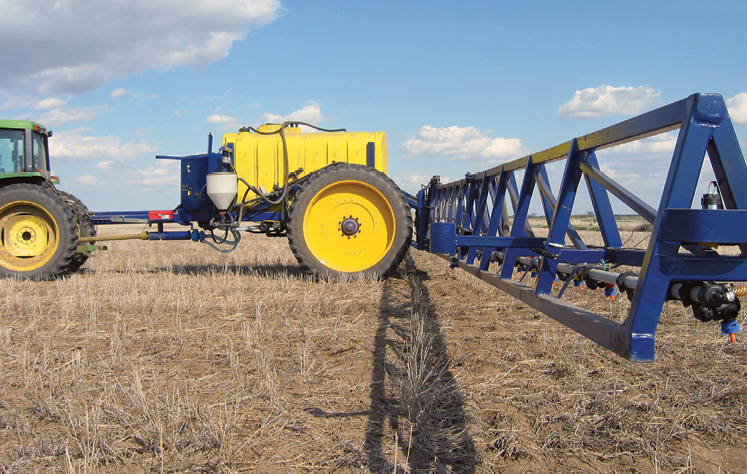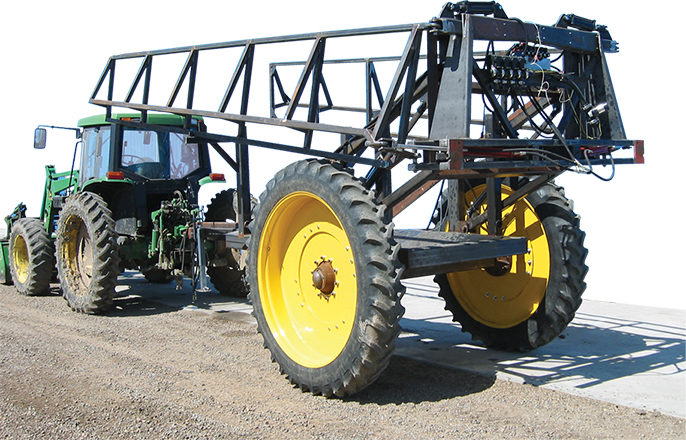Pull-type sprayers are still one the most important tools on the farm for no-tillers as they push for higher yields on acres being covered multiple times to apply herbicides, insecticides, fungicides, nutrients, plant hormones, growth regulators and more.
Some have opted for self-propelled sprayers to boost the number of acres they can cover. But others find that pull-type sprayers give them more flexibility and they might even be able to get into a field in rougher shape without causing major soil damage.
Besides having to handle more acres, producers are also expecting more from their pull-type sprayers, including better accuracy and rate control, and the ability to handle more volume. New pull-types can be ordered up with bells and whistles that deliver these benefits, but farmers can do a lot to improve the sprayers they already have.
Flexibility Is Key
Paul Anderson, who no-tills near Coleharbor, N.D., uses two 96-foot Miller Spray-Air pull-type sprayers to cover 12,000 spray acres every year. His rotation includes no-till wheat followed by strip-till corn and then no-till peas, lentils, sunflowers or dry beans. When June rolls around, he needs to cover a lot of acres in a short time.
“We need to be spraying herbicides and applying fertilizer at the same time,” Anderson says. “By owning two pull-type sprayers we’re able to cover more acres and save time by not having to switch systems between fields to apply those products.
“And, if one of the tractors breaks down we can just hook the sprayer to another tractor. You can’t do that with a self-propelled unit.”
A self-propelled sprayer may speed application, but it also doesn’t fix having to switch out systems between fields, and two pull-type sprayers are cheaper than two self-propelled units.
Auto Shutoffs Save Money
Fields that don’t measure up nice and square can result in significant overlap and over-application of expensive inputs.
Having irregular fields is what proved Anderson’s investment in a Rinex AS7500 automated-section controller and Raven 450 spray-rate controller, for both of his sprayers, would quickly turn a profit.
“The first time I took the new system out I sprayed a 252-acre triangular field that has 20 power poles cutting through it,” Anderson says. “Normally it takes me 280 acres of product to spray that field, but with the auto shutoffs my meter read 254 applied acres. I saved $600 in chemicals the first time I used the system.”
The savings from that first application helped set him on the path to recouping his upgrade investment. The upgrade cost him $1,800 for the Rinex, $1,000 to upgrade to the Raven 450 6-switch monitor — which was needed to handle adding in more boom section control — and $300 for two additional valves.
“It really improved the accuracy of the on-and-off timing on the booms. And adding more sections helped even more,” Anderson says.
His spray booms were originally set up in three manually controllable sections. When he added the auto-boom shutoff and rate controller, Anderson also tacked on two additional valves to each sprayer to allow for five automatically controlled boom sections.
“The smaller the section of shutoff, the less over-spray you have,” Anderson says. “I went from 10% overlap on some fields down to just 1% overlap. And with herbicide at $20 per acre and fertilizer even higher than that, it adds up quick.”
Anderson had enough room on his sprayer-valve stack to pin on and plumb in two additional Raven valves. Each wing of the sprayer was broken into two controllable sections. Those were hooked to the Rinex controller in the cab and linked up with GPS.
“The people that designed the Rinex manual deserve a Pulitzer prize for technical writing,” Anderson says. “I was able to hook it up, use the constants to calibrate, and head straight to the field to spray. I didn’t have to call a technician once while installing and setting up this system.”
He also liked the fact that the Rinex is compatible with most other systems. It plugs into his Outback auto-steer system for GPS signals, and the Raven monitor for rate control.
Besides reducing overlap, the automatic shutoffs make spraying a little easier on Anderson’s 70-year-old father.
“He doesn’t have to keep his right arm sitting on the switchbox, so it’s a lot easier on his shoulders,” Anderson says. “He can just fold out the sprayer, turn on the pump and drive. It takes stress off him and makes him able to participate in farm work more effectively.”
A Clean Sweep
Robert Pardoe of Milton, Penn., no-tills corn, soybeans and alfalfa and uses his 45-foot, 500-gallon Paul B. Zimmerman (now CropCare) sprayer to apply herbicides and insecticides and dribble on nitrogen.
He picks up extra work doing some custom spraying to bring his spray acres to around 1,000 per year.
Having sensitive soybeans and young alfalfa in his rotation have taught Pardoe how important sprayer cleanout can be.
“I would think my sprayer was clean enough and would move to the next field to spray a different product,” he says. “Sometimes I would get a burn on the first 50 feet of the next crop I sprayed — especially soybeans and young alfalfa — because of that tiny bit of diluted residue in the sprayer.”
Pardoe discovered that despite having a rinse tank with enough capacity to rinse his sprayer twice, there would always be a gallon or two of water that wouldn’t come out when he ran the pump dry.
To get the sprayer as clean as possible, he’d have to take the cover off of the filter and drain the last liquid. This task wasted time and required him to dispose of a gallon or more of liquid.
Pardoe’s solution was to install a solenoid valve on the pipe next to the filter. “Now while I’m still in the field dispersing rinse water, I can simply flip a switch from the cab and get every last bit of the rinse water out of the sprayer,” he says.
He also added an Ag Leader Edge display and auto-steer to his tractor, making his hours spent spraying even easier.
“The auto-steer made a major difference in my ability to spray accurately,” he says. “I would never use a foam marker again.”
Capacity And Accuracy
John Janing, a no-tiller near Geneva, Neb., has upgraded his 1,000-gallon pull-type Bestway sprayer twice since purchasing it used in 2002.
Janing immediately extended the 45-foot spray booms to 60-foot booms to match the rest of the equipment used to seed and manage their no-till corn, soybeans, winter wheat and forages. He also changed out all the ¾-inch hose for 1-inch hose.
“That was when soybean rust was rumored to be coming, so we wanted to have the hose capacity to handle the 20-gallon-per-acre spray volume they said we would need for fungicides,” Janing says.
Though soybean rust never came, he gained efficiency as it took less energy to push product through larger hoses, and it gave him more flexibility in other applications.
“We’ve pushed spray volume to get better control of late-season weeds, when weather has kept us out of the fields and the larger hoses have helped with higher rate in-season fertilizer applications,” he says. “Without the 1-inch hoses, we would have been more limited.”
The sprayer is used for “everything but irrigating,” Janing says. It covers 2,000 spray acres applying herbicides, insecticides and fungicides. He also uses it to broadcast fertilizer on wheat, sidedress nitrogen on corn and occasionally to apply in-season micronutrients.
When purchased, the sprayer was a speed-pressure system, requiring that the operator maintain a steady speed for rate control.
Janing never even took it out of the yard before installing a Hiniker rate controller for automatic rate control no matter the speed. After that upgrade, Janing simply had to drive 500 feet, press a button and the unit would automatically calibrate and maintain application rates accordingly.
“We could speed up or slow down as conditions warranted and maintain a more accurate rate,” he says.
The initial upgrade also included electric ball valves for the spray-boom controls, and a Fasse hydraulic-valve multiplier so he could run the hydraulics from one tractor spool.
The pull-type was upgraded again last year with a Trimble FmX integrated display, auto-steer and automatic boom control. He stuck with the Trimble EZ-Boom system over other systems to keep extra monitors from cluttering up his cab.
“When we purchased the FmX we also got the EZ-Boom sprayer add on,” Janing says. “We just had to put a small controller on the sprayer and were able to add a Raven servo valve and use our existing Hiniker flow meter.”
The upgrade gave Janing the ability to do variable-rate applications — which he hasn’t tried yet — and auto-boom shutoff. Unlike with his old system, with auto-boom a tired or busy operator won’t switch off a boom section and forget to turn it back on.
“Because our fields are mostly square, the auto-steer and auto-booms haven’t had much cash return on the investment,” Janing says, “But it has greatly reduced driver stress and that’s important, too.”
Adding these capabilities to a 1990s-model pull-type sprayer has proven to be a major money saver, he adds.
“I was able to purchase this sprayer used for $4,000 and add the things I need to it,” he says. “That’s a much better deal than a $250,000 self-propelled unit, or a brand new pull-type.”
Taking Charge

In 2003, Joerg Klempnauer didn’t just upgrade an old pull-type sprayer. He built his own pull-type from scratch to manage his winter wheat, peas, flax, spring barley, mustard and beans.
With 40 years experience with mechanical work, and 30 years of farming trial and error, the minimum tiller from Grassy Lake, Alberta, Canda, felt confident in the task.
Klempnauer has retired from large-scale commercial farming and ran a food-grade pea-processing and export company before returning to farming on a smaller, test-farm basis.
He built his first sprayer in 1990 because he couldn’t find a high-clearance sprayer with a self-leveling, 80-foot boom that could withstand the impact of deep pivot tracks. He made even more improvements on the sprayer he built in 2003 as its replacement.
While building a sprayer from the ground up isn’t for everyone, there are some improvements he factored in that could be easily applied to existing sprayers.
One of the simplest changes was installing 5-nozzle quick-change bodies. When Klempnauer needed to switch his nozzles, he could simply rotate them to the spray tip that was right for the job at hand.
“We would switch nozzles four or five times per year due to different crops and different sprays,” he says. “It would easily average 4 to 5 hours of changing out 48 nozzles on an 80-foot boom. And if you wanted to spray two different crops in one day that was valuable time wasted.”
Cost is definitely a factor with this quick-change upgrade. With 48 nozzles then at around $30 each, the improvement cost more than $1,400. But it kept the sprayer moving and he always knew where his nozzles were.
“Normally you’d have three different nozzle types in a bag somewhere in the shop and not know where they were when you needed them,” Klempnauer says. “It’s just convenient to have them all right there on the boom. It makes life easier.”
His new sprayer features a chemical-injector tank that can be lowered to the ground to pre-mix chemical and pump it into the tank. It’s a simpler system that allows for better mixing. The sprayer tank is also equipped with wash nozzles so the operator could flip a switch in the cab to wash the tank with clean water.
“Going home with a clean sprayer is definitely preferred,” Klempnauer says. “Otherwise you end up in the yard with a contaminated sprayer and that isn’t ideal.”
Larger, 52-inch tires were yet another addition.
“With larger wheels there is less pulling power needed and less rutting and impact on the field,” Klempnauer says. “It also gave me 36 inches of clearance, allowing me to make important fungicide applications without damaging the crop.”
As with his original sprayer, Klempnauer wanted an automatic boom-leveling system. But the larger-capacity sprayer needed constant hydraulic control to maintain boom height. The tractor he was using didn’t have the oil capacity to operate both boom height and the sprayer pump.
The solution was to use a PTO-driven pump and dedicate hydraulics to boom-height control.
Though likely impossible to add to an existing sprayer, Klempnauer also added a hitch controlled by a hydraulic cylinder to steer the pull-type sprayer behind the tractor.
“I wanted it to trail properly so that it would stay in the row and not crush the crop,” he says.








Post a comment
Report Abusive Comment